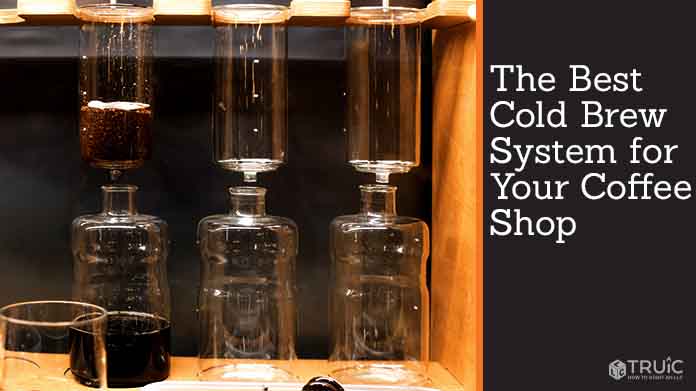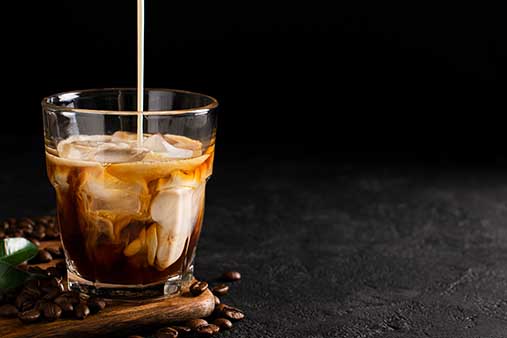The Best Cold Brew System for Your Coffee Shop
From coffee trend to cafe staple, cold brew beverages now grace the menus of most coffee shops all year round. Just one question remains: What’s the best way to make cold brew in your cafe? This article examines a few of the best immersion-based cold brew options for your business.
Recommended: Read our full, in-depth How to Start a Coffee Shop Business guides, inspired by coffee professionals, they will help make your coffee dreams real, from sourcing beans to hiring baristas, choosing the best POS system, forming an actual company, and everything in between.

Cold Brew vs. Iced Coffee
The difference between cold brew and iced coffee lies in the brewing method. Cold brew coffee involves brewing coffee slowly with cold water. Typically made as a concentrate to later cut with water, cold brew coffee usually has a high caffeine content and a bold taste.
In contrast, iced coffee is simply hot coffee poured over ice. That makes it less flavorful and less caffeinated than a cold brew coffee. Furthermore, cafes create cold brew coffees with the intention of serving them with ice. While melting ice enhances a cold brew coffee, it waters down an iced coffee over time and makes it less desirable.
The History of Cold Brew
Coffee has many origin stories and the cold brew version of this popular beverage is no exception. While many people believe this brewing method originated in a number of Asian countries, the cold brew process commonly used today started in Japan roughly 200 years ago.
From there, cold brew coffee evolved into another form in the American South as people brewed it in a similar way to the region’s popular sweet tea. New Orleans helped boost the popularity of cold brew coffee based on its version flavored with chicory. With the rise of third-wave coffee during the last 10 years, cold brew coffee emerged as a popular choice across the United States and worldwide.
The Immersion Method
Immersion is one of the most popular methods for making cold brew coffee. It involves coarsely grinding coffee beans, immersing the grounds in cold water for 12 to 16 hours, and then straining the mixture through a filter to produce a concentrate.
To use this brewing method, you’ll need:
- Coffee
- Cold water
- A paper, mesh, or metal filter
- A cold brew system
Recommended Immersion Systems
Finding the right immersion system for your cafe’s cold brew coffee often involves comparing products that seem relatively similar. To help you make the best choice for your business, here’s a comparison of three leading immersion cold brew systems:
Toddy® Commercial Cold Brew System
The industry darling of immersion cold brewing, Toddy manufactures cold brew systems that enable cafes to make this beverage in a range of quantities. The commercial size that produces up to 2.5 gallons of cold brew at a time is a good option for cafes just starting to offer cold brew beverages. The Toddy system comes with paper filters as well as an outer liner — usually a mesh bag that provides additional filtration and stability for the paper filter within the brewer — to deliver the best filtration possible and ensure a clean cup of cold brew coffee.
Pros:
- To improve its sustainability, Toddy cold brew systems offer compostable, tree-free filters.
- The paper filters eliminate the issue of clogging — a common problem with metal filtration.
- You can use this system to make both concentrate or ready-to-drink cold brew coffee.
Cons:
- The plastic construction is less sanitary for food preparation than stainless steel.
- It requires an additional investment in single-use paper filters rather than a reusable mesh or metal option.
Price: $99.99
Ease of Use – 3.5/5
This system’s method of filtration — submerging a large, tied filter of coffee in water for 12 hours — requires more labor than competitors’ products. You’ll either need your baristas to remove the filter and squeeze out any excess liquid or you’ll have to invest in a strainer to hold the filter as it drains.
Value – 4.5/5
Based on its plastic construction, Toddy systems cost far less than competitors’ systems that use metal as their body material.
Additional Features – 4/5
This system provides all the necessary features to make great cold brew coffee while keeping the process simple. However, it offers few innovations beyond its compostable filters — a new and sustainable addition.
Curtis Cold Brew System and Dispenser
More commonly known in the coffee industry for its drip coffee makers, the Curtis brand also offers an easy-to-use cold brew system and dispenser with a clean, sleek appearance. The smallest size of this system is six gallons, making it slightly larger than its competitors. This system also comes with paper filters and a strainer to enhance filtration.
Pros:
- With both a brewer and dispenser, this system makes it convenient to serve and brew coffee during busy times while eliminating the need for extra equipment like pitchers.
- The sloped bottom makes it easy to dispense every drop of cold brew coffee.
- Its stainless steel body is easier to clean and more sanitary than plastic.
Cons:
- This system’s large size can pose a challenge for small cafes that lack the space or customer demand for as much cold brew as it can produce.
- Due to its size, this system has a higher price point than competing brands’ smaller systems.
Price: $257.99
Ease of Use – 4.5/5
Equipped with a sturdy strainer and dispenser, this system makes the process of cold brewing super simple. The only negative is the use of paper bag filters that require baristas to remove a heavy bag of wet coffee grounds and place them in the strainer.
Value – 3/5
Due to its stainless steel body, this cold brew system comes with a much higher price tag than its competitors. However, a system made from metal instead of plastic provides a more sanitary option for food production.
Additional Features – 4/5
This system’s inclusion of both a brewer and a dispenser provides a helpful feature because it allows users to brew with one piece of equipment rather than several.
Brewista® Cold Pro 2™ Commercial Brewing System
Along with its combined brewer and dispenser, the Brewista Cold Pro 2 offers a strong focus on convenience. With a six-gallon output and an easy-to-remove filter basket, it makes the production of cold brew coffee truly simple (and inexpensive). This system also comes with a removable filter and an integrated pouring spout.
Pros:
- The system’s angled bottom makes it easy to dispense every drop of cold brew coffee.
- It offers a lower price point than its competitors without sacrificing quality or ease of use.
- Its lift-and-twist design makes it easy to drain and remove the filter.
Cons:
- Its plastic construction provides a less-sanitary option than systems built of materials like stainless steel.
- Cafes that don’t sell a large volume of cold brew coffee may find this system’s large size inconvenient.
Price: $69.95
Ease of Use – 4.5/5
This system’s removable filter allows baristas to effortlessly drain, disconnect, and clean the filter.
Value – 5/5
Despite delivering several improvements on the classic cold brew system model, the Brewista Cold Pro 2 system remains cheaper than its competitors.
Additional Features – 5/5
Not only does this system brew and dispense fresh cold brew coffee, but it also has an easy-to-remove filtration basket that simplifies draining and cleaning.
The Bottom Line
As a small business owner, you need an efficient, affordable, and easy-to-use cold brew system. The immersion cold brew system that includes all of those traits is the Brewista Cold Pro 2 Commercial Brewing System. At a lower price than its competitors, this system also includes innovative features to make brewing undemanding.
Want to learn more about cold brew coffee? Read this guide about starting your own cold brew company.

